| Article ID | Journal | Published Year | Pages | File Type |
|---|---|---|---|---|
| 6385501 | Fisheries Research | 2015 | 9 Pages |
Abstract
Determination of unit-stock structure and the assignment of individuals from mixed groups to stock-of-origin is important to conservation and management of Arctic riverine fishes. Northern form Dolly Varden Char (Salvelinus malma malma) are closely linked to perennial groundwater sources during the freshwater stages of their life cycle. This close connectivity provides an ideal circumstance for stock discrimination using archived sagittal otoliths (1986-2007) collected from the river drainages of the study area (Firth River, Yukon Territory (YT), Babbage River, YT, Big Fish River, Northwest Territories (NT), Rat River, NT, and Vittrekwa River, NT). Laser ablation-ICP-MS techniques were employed to measure 87Sr/86Sr isotopes and trace elements (Sr, Ba, S, Zn, Mg, P) from dorso-ventral otolith thin sections. Random forest model, learning algorithm and tree classification provided 94.4% classification success for individual fish to the river systems (putative stocks). Misclassifications within the model occurred among the Vittrekwa, Babbage, and Rat river drainages. Strontium, 87Sr/86Sr ratio and Ba were the most significant discriminators within the model, although removal of the remaining elements reduced overall discriminatory power. Microchemical analyses of archived otoliths provided high classification and discrimination success thus can be used as a tool for fisheries managers in developing effective management and conservation plans regarding mixed-stock fisheries for this species.
Related Topics
Life Sciences
Agricultural and Biological Sciences
Aquatic Science
Authors
Tracey N. Loewen, James D. Reist, Panseok Yang, Alison Koleszar, John A. Babaluk, Neil Mochnacz, Norman M. Halden,
